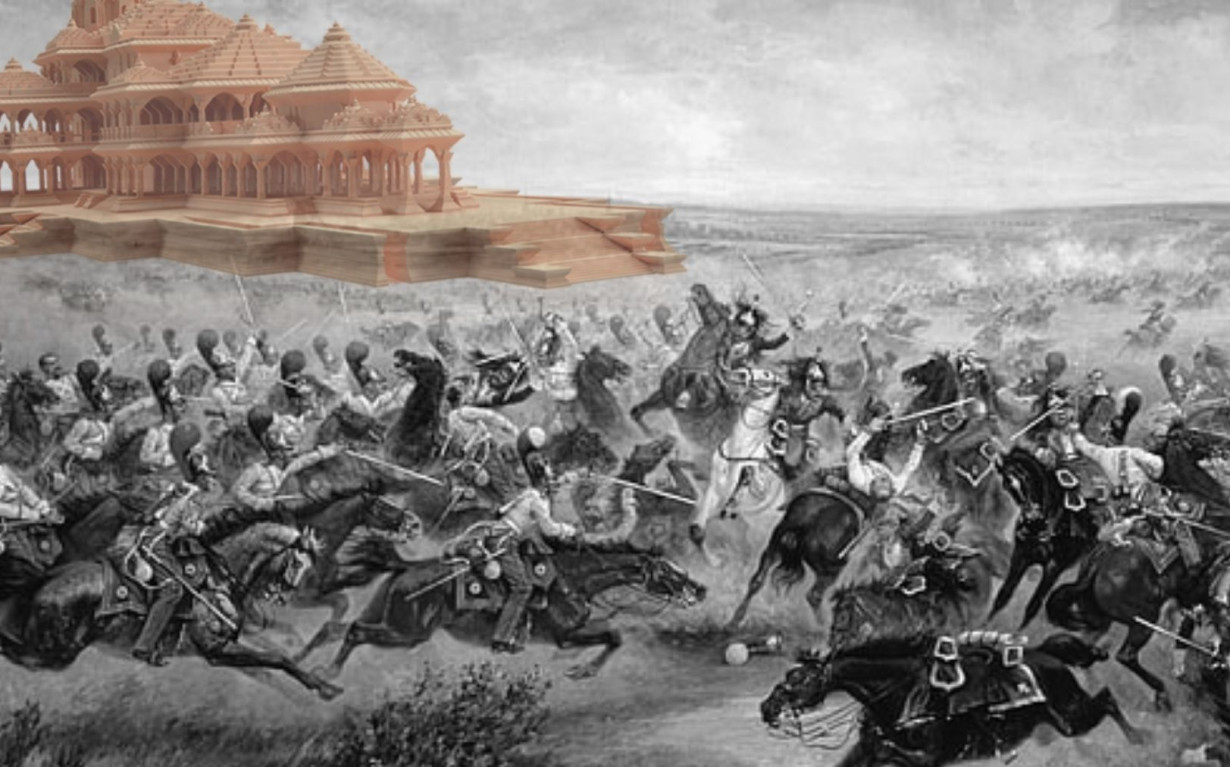The upcoming Pran Pratishtha, or inauguration ceremony, of the Ram Janmabhoomi Temple in Ayodhya on January 22, 2024, marks the culmination of a centuries-long journey filled with perseverance, resilience, and maturity. This historical narrative is deeply rooted in Ayodhya’s significance as the capital of the Ikshvaku dynasty and the birthplace of Bhagwan Shri Ram. The construction of the Babri structure in 1528-29 CE by the Mughal ruler Babur initiated a prolonged struggle, showcasing the enduring spirit of the Bharatiya people.
At its core, the story revolves around Ayodhya’s historical significance and the timeless tale of Bhagwan Shri Ram, born to King Dasarath and Queen Kausalya during the Treta Yuga. The narrative symbolises virtue triumphing over vice and light dispelling darkness, as recounted in the Hindu scriptures of Ramayana and Skanda Purana. The deliberate destruction and occupation of the Shri Ram temple by Mughal tyrant Babur marked a significant turning point in Ayodhya’s history, suppressing the cultural and religious heritage of the Hindu community.
During the Islamic occupation of Bharat, many temples, including one in Ayodhya, were systematically destroyed. Mir Baqi, a General under the Mughal ruler Babur, demolished the Shri Ram temple, a site of great importance as Bhagwan Ram’s birthplace. In its place, he constructed the “Babri mosque.” Historical records suggest that Babur may have ordered the construction, albeit never personally visiting, supposedly in the name of Baburi Andijani—a young male lover slave he rescued in 1499. Babur openly expressed his affection for Baburi in his autobiography, the Baburnama. Furthermore, the Babri structure did not emerge as a place of prayer; rather, it stood as a deliberate attempt to humiliate Hindus—a calculated endeavour to obliterate their cultural and religious heritage.
Numerous historical accounts, including those of revered Sikh Guru Nanak, Chinese traveler Hiuen Tsang, and scholars such as Edward Balfour and A. Fuhrer, corroborate the intentional destruction and occupation of the Ram Janmabhoomi by Babur. These accounts converge on the narrative of Shri Ram’s temple and the persistent yearning among devotees for the restoration of his sacred birthplace. The legal saga surrounding the Ayodhya Ram Janmabhoomi issue spans 168 years, with the first case filed in 1858 by Mohd Salim against Nihang Sikhs that inscribed “Ram” inside the Babari structure. The legal battles intensified in post-Independence Bharat, witnessing significant developments in 1949 when the idol of Shri Ram was discovered beneath the central dome of the Babri Structure. This led to heightened altercations and a ban on the area, with both Hindus and Muslims filing civil cases to gain control. The Vishwa Hindu Parishad (VHP) formed a group in 1984, and in 1986, the Faizabad district judge ordered the opening of the gates for Hindu prayers. However, this sparked counter-movements from Muslims, leading to the Ayodhya Dispute Title Suit being transferred to the Allahabad High Court in 1989. The situation evolved with the Rath Yatra in 1990 and the Babri structure’s deconstruction by Kar Sevaks in 1992 after years spent in pursuit of redressal from non-responding governments, resulting in tragic loss of lives of over 50 Kar Sevaks.
Following the deconstruction of Babari structure, the Liberhan Commission was established in 1992 to investigate the events. In 1993, the Narsimha Rao Government issued an ordinance acquiring land in Ayodhya, formalized as the Acquisition of Certain Areas at Ayodhya Act, 1993. The Ismail Faruqui Judgment by the Supreme Court in 1994 upheld the constitutionality of the Act. Subsequently, the Ayodhya Title Dispute Case resumed in 2002 at the Lucknow Bench of the Allahabad High Court. In 2003, the court directed the Archaeological Survey of India (ASI) to excavate the site, revealing concrete evidence of a temple dedicated to Bhagwan Ram. The verdict on September 30, 2010, distributed the Ayodhya title in a 2:1 ratio, with the Supreme Court staying the Allahabad High Court order in 2011.
The Supreme Court rejected a plea for a five-judge Constitution Bench in 2018, opting to maintain a three-judge bench. Chief Justice Dipak Misra retired in 2018, and on January 8, 2019, Chief Justice Ranjan Gogoi reassigned the Ayodhya Dispute to a five-judge Constitution Bench. Mediation efforts began in March 2019, and final arguments commenced in August 2019, with the judgment reserved in October. On November 9, 2019, the historic final judgment awarded the title to Shri Ram and an alternative site in Ayodhya to the Sunni Waqf Board for a mosque. The court mandated the establishment of a trust, leading to the formation of the Shri Ram Janmabhoomi Teerth Kshetra Trust. The temple’s development has been solely funded through crowdfunding, without any public or government funding. In accordance with the Supreme Court decision, the Uttar Pradesh Sunni Central Waqf Board established the Indo Islamic Cultural Foundation (IICF) for the construction of the Dhannipur mosque. The proposed site includes a library, museum, hospital, community kitchen, and a research center. Notably, 40% of the funds gathered for the Dhannipur mosque were contributed by Hindus.
Approaching its inauguration, the Ram Janmabhoomi Temple becomes more than a mere architectural spectacle, taking on profound significance in the hearts of millions of global devotees who hold Lord Ram in deep reverence. It symbolises Bhagwan Ram’s central importance across diverse global cultures, transcending its physical structure. The extensive respect for the temple’s construction, marked by contributions from countries like Nepal, Thailand, Sri Lanka, and Indonesia, underscores the sentiment of universal devotion and admiration for Bhagwan Ram, uniting people across borders in the creation of this sacred space.
The Ram Janmabhoomi Temple is a symbol of the triumph of faith over adversity and the restoration of a cultural and religious heritage intentionally erased centuries ago. Scheduled for consecration on January 22, it serves as a beacon of hope for a united and inclusive Bharat. This historic moment is a powerful testament to the enduring spirit of a nation that, after nearly a 500-year wait, stands ready to embrace this transformative occasion with reverence and joy.

